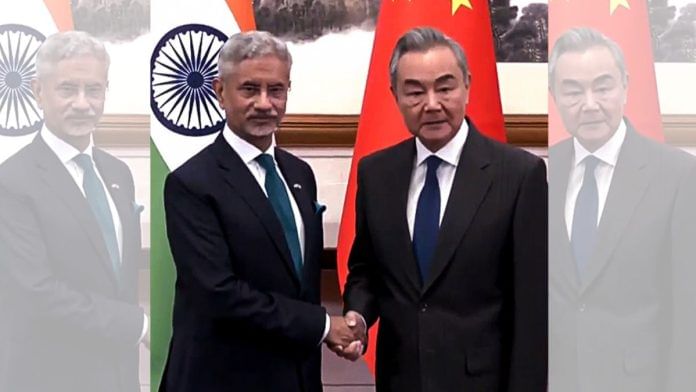New Delhi: De-escalation of troops in the icy heights of eastern Ladakh, restarting of patrolling in key areas along the Line of Actual Control and resumption of direct flights between the two countries—these top the agenda for talks between visiting Member of the Politburo of the Communist Party of China and Chinese Foreign Minister Wang Yi and the Indian leadership.
The top Chinese diplomat, who is in India on 18-19 August to carry forward the 24th round of the Special Representatives’ (SR) talks on the India-China boundary question with India’s SR, National Security Adviser Ajit Doval, will also call on Prime Minister Narendra Modi late Tuesday evening.
He will meet External Affairs Minister S. Jaishankar Monday evening.
Talking about their expectations from the visit, Chinese Foreign Ministry spokesperson Mao Ning said Monday, “China is willing to take the opportunity of Wang’s visit to India to work together with the Indian side in implementing the important consensus reached by the leaders of the two countries, maintain the momentum of high-level exchanges, enhance political mutual trust, strengthen practical cooperation, properly manage differences, and promote the sustained, healthy, and stable development of China-India relations.”
Sources said, groundwork is being laid for Modi’s visit to China at the end of this month for the Shanghai Security Cooperation Summit.
While sources in the defence and security establishment remained tight-lipped about the agenda for the meeting, they said that de-escalation remains on the top of the agenda along with resumption of patrolling rights.
“For overall bilateral relations to grow, border tensions have to come down. Need to go back to the earlier status quo,” a source explained.
The de-escalation would mean that several of the additional troops and equipment which remain deployed in the forward areas would move back to peacetime locations even as the permanent troops deployed there remain.
While winters see thinning down of troops, additional soldiers are deployed as part of the summer deployment plans.
The border crisis in eastern Ladakh which started in May 2020 has seen India at one point deploy an additional 68,000 troops, nearly 90 tanks and around 300 infantry combat vehicles in eastern Ladakh.
The Chinese too had similarly built up and deployed additional troops and equipment.
In February 2024, the two sides agreed to avoid any further build-up of troops in Ladakh, as reported by ThePrint.
Both sides had agreed that there won’t be “too much” build-up of troops in eastern Ladakh in the coming summer, with both sides having withdrawn a significant number of soldiers as part of the winter deployment pattern.
However, as reported, disengagement from Depsang Plains and Demchok remained a thorn in the side of India-China ties.
Later, on 21 October 2024, Indian Foreign Secretary Vikram Misri announced that a bilateral agreement had been reached to disengage at the friction points, which set the stage for a political thaw of sorts between New Delhi and Beijing.
As reported by ThePrint 30 October, India and China disengaged from the two face-off points of the Depsang Plains and Demchok in eastern Ladakh, pulling back troops to the pre-2020 positions and also dismantling all check posts, defensive positions and housing and shelters created in the past four-and-a-half years.
On 4 November, the Indian Army carried out its first patrol in the Depsang Plains, almost two weeks after it signed a disengagement agreement with China’s People’s Liberation Army (PLA).
External Affairs Minister S. Jaishankar had in July this year told Wing Yi that while India and China had “made good progress” in the past nine months towards normalisation of bilateral ties, both countries should now aim for de-escalation along the borders.
Another issue high on India’s agenda is resumption of regular patrolling at the friction points where disengagement had taken place earlier—Galwan Valley, Pangong Tso, Gogra (PP-17A) and Hot Springs (PP-15).
Sources also said the Chinese are very keen on restarting direct flights between the two countries and have been pushing for it along with opening up investment avenues.
(Edited by Viny Mishra)
Also read: India in talks with China for resumption of trade via 3 border passes ahead of Modi’s SCO visit






